| |
 |
June 2016 |
 |
|
| |
| |
|
Welcome
Welcome to the June issue of the USAPEEC ASEAN Regional Office’s newsletter.
This newsletter seeks to provide readers with useful product and major market information for institutional and consumer users of U.S. poultry. Readers will find in every issue a variety of general market information, program activities as well as useful product information.
This issue, we share several activities that took place in Southeast Asia.
Contents:
- China is becoming a dominant source of export growth for ASEAN countries
- Singapore signed bilateral agreements with Mexico
- Guidebook to help aspiring F&B entrepreneurs
- Market access update after notification of AI-free status in 2016
- Singapore restaurants expanding beyond their home turf
- Mookata in Southeast Asia
- Poultry & eggs in Southeast Asia festivals
|
|
|
| |
|
|
|
| |
|
Additional Market Information Available
We have updated our website to include more information on market reports and export documentation guidelines.
You can visit our ASEAN website at: www.usapeecasean.com |
|
|
| |
|
|
|
 |
|
China is becoming a dominant source of export growth for ASEAN countries
China is becoming a larger driver of export growth for Asian economies than the United States and the European Union. China is a bigger major export market than the United States for five of the larger economies in ASEAN, namely Indonesia, Malaysia, Philippines, Singapore and Thailand. The exception is Vietnam, which exports more to the United States than to China instead.
Exporting Country |
Destination Market for Exports of All Commodities in 2015 (US$ billion) |
|
China |
United States |
Malaysia |
53.2 |
33.7 |
Thailand |
37.2 |
28.6 |
Singapore |
26.2 |
18.1 |
Vietnam |
23.8 |
37.5 |
Indonesia |
19.8 |
19.5 |
Philippines |
19.0 |
10.1 |
In the agricultural sector, China imported a total of US$23.5 billion of agricultural fish and forestry products from the Southeast Asian region. In the same year, the United States imported a total of US$15 billion from ASEAN under the same commodity sector.
|
|
Section of the busy Singapore port |
| |
|
|
|
|
|
Singapore signed bilateral agreements with Mexico
Singapore signed three memorandums of understanding (MOUs) with Mexico in the first week of June 2016. The MOUs cover areas such as agriculture, food, education and technical cooperation. Singapore is globally known as the regional hub of Asia while Mexico is dubbed as the regional hub for much of South America. Both countries can leverage on their roles as gateways to their respective regions to boost international trade between Asia and South America.
Both countries are signatories to the recently concluded Trans-Pacific Partnership that covers 12 countries, making up 40 per cent of the world’s agricultural trade economy. Agricultural trade between the two countries is at a modest and restricted level in terms of variety and range. Singapore imported about US$15.6 million worth of agricultural products from Mexico in 2015 and exported US$19.7 million of agricultural products to Mexico in the same calendar year. Four main imports from Mexico are abalone (US$5.4 million), beer (US$2.8 million), chocolates (US$1.2 million) and bananas (US$1 million), forming almost two-thirds of all total imports from Mexico. Major Singapore exports include malt extract, flour, meal, milk products (US$8.2 million), essential oils (US$2.1 million) and cloves (US$2.1 million), which comprise almost two-thirds of Singapore exports to Mexico. |
|
 |
Canned abalone from Mexico, New Zealand and Australia displayed in a supermarket cabinet |
| |
|
|
|
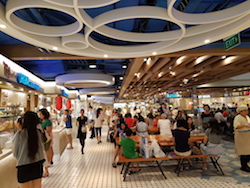 |
|
Guidebook to help aspiring F&B entrepreneurs
A survey carried out by the Singapore government statutory board, SPRING Singapore, reported that only 60 per cent of food service establishments survived their first five years of operation. The average small businesses faced an annual operating loss of 8 per cent and took up to 2.5 years to break even. According to SPRING Singapore, about 85 per cent of the approximately 5,000 food service enterprises in Singapore consist of micro and small businesses.
The Restaurant Association of Singapore (RAS), together with SPRING Singapore and National Environment Agency (NEA), has launched a guidebook for food and beverage (F&B) entrepreneurs. The ‘Turning Passion into Profits’ guidebook aims to help F&B entrepreneurs better comprehend the challenges of establishing a business and improve its operating efficiency. These include equipping entrepreneurs with a better understanding of business conditions and potential pitfalls, as well as sharing tips and comparative information to take on a systematic approach to evaluate the viability of their respective businesses. |
|
Small and micro food enterprises in a food court |
| |
| |
|
|
|
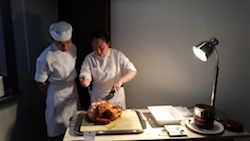 |
|
Market access update after notification of AI-free status in 2016
The three leading ASEAN markets in CY2015 for U.S. poultry were Vietnam (85,505 metric tons), Philippines (77,646 metric tons) and Singapore (33,486 metric tons). They have lifted the market barriers imposed during the AI outbreaks that occurred over most of 2015.
The following is a brief summary of market access status for U.S. poultry in the other ASEAN countries:
- Thailand is a significant market for U.S. frozen turkey and has continued the restrictions imposed during the 2015 AI outbreaks by not accrediting any turkey establishment plant eligible for export to the Thai market.
- Indonesia has still not accredited any poultry establishment eligible for exports of Halal-certified poultry to the country.
- Similarly, Brunei, for more than a decade now, has not accredited any U.S. poultry plant eligible to export Halal-certified poultry to the Sultanate.
- Malaysia currently allows only one turkey plant, Turkey Valley, to export Halal-certified turkey to the Malaysian market.
- Myanmar permits the import of poultry which are designated for the hotel and restaurant trade only.
|
|
U.S. roast turkey carving at a trade reception in Singapore |
| |
|
|
|
|
|
Singapore restaurants expanding beyond their home turf
Restaurants in Singapore are faced with the constraints of a small domestic market, rising retail rentals and wages. They have looked beyond the island nation for expansion opportunities. The Les Amis Group recently opened restaurants in Indonesia and Philippines. Crystal Jade restaurants have already established their presence in 10 other countries, including China, Hong Kong, Indonesia, Myanmar, USA and Vietnam. Similarly, the Bread Talk Group has expanded to 15 countries, including Indonesia, Malaysia, Thailand, Taiwan, Hong Kong and China. Another F&B group, Zest, which owns Twelve Cupcakes International, has expanded to Indonesia, Malaysia, Taiwan and Hong Kong since 2011.
Expanding overseas has enabled Singapore-based F&B groups to achieve scalability, lower operating costs and greater availability of service staff. Singapore restaurants with high brand name recognition in the island nation are able to expand rapidly in the new markets and establish a loyal customer base in a short period of time.
|
|
| |
|
|
|
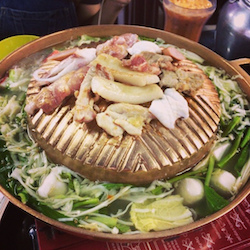 |
|
Mookata in Southeast Asia
“Moo” in Thai is “pork” while “kata” loosely refers to the “skillet”. It is the brainchild of combining the steamboat and grill. Its dome-shaped grill has a soup trough placed over charcoal cinders.
One theory claims that Mookata came about from Korea, when it was being divided into North and South Korea. During the war, food was severely scarce. The famished Korean soldiers found raw dog meat and cooked it on their heated steel helmets to survive. Another story is about the Thais and how they became aware of delicious Korean barbeques. Thais delight in eating sukiyaki beef and enjoy a soupy dish as they dine out1. Thai restaurant owners adopted the Korean barbeque concept and added a soup trough to it and Mookata was born. Mookata has been a rampant hit in Thailand for nearly 10 years2.
The Mookata trend caught on in Singapore since early 20143. Numerous restaurants and local coffee shops, such as Mookalicious and Huay Kwang Thai Kitchen4, offer two different dining options. One comes as a fixed set of pork collar, pork belly, chicken sausages and leafy vegetables while the other is a buffet-style of free-flow pork, beef, chicken, seafood and vegetables. The uniqueness of Mookata lies in its comforting soupy broth accompanied by special homemade sweet and spicy dipping sauces.
Mookata involves greasing the grill with pork lard before placing the raw meat on it. Butter is typically used in barbeques. With Mookata, pork lard is preferred as it adds fragrance when grilling the meats, making them tender and charred to perfection. The pork lard will melt over the hot grill. As it produces oil, it drips from the top of the dome into the broth area. The broth that is served when consuming Mookata is usually simmered down for at least five hours, using chicken and pork bones. When diners add chicken, seafood and vegetables into the soup, the broth becomes enhanced with rich and bold flavors from the mixture of the hotpot ingredients and meaty juices oozing from the grill.
The grilling of the tender meats and sipping of delicious soupy broth are just a few of the reasons why Mookata is unique, as it marries the concept of the steamboat and grill.
References:
1 The Straits Times (2016). From Cheese Tarts to Mookata: 11 Food Fads That Whetted Singaporean Appetites. [online] Available at: http://www.straitstimes.com/lifestyle/food/from-cheese-tarts-to-mookata-11-food-fads-that-whetted-singaporean-appetites
2 Makansutra (2014). New Udon: Is Mookata Korean Inspired? [online] Available at: http://www.makansutra.com/stories/3/1227/NewUdonIs MookataKoreaninspired
3 The Straits Times (2016). From Cheese Tarts to Mookata: 11 Food Fads That Whetted Singaporean Appetites. [online] Available at: http://www.straitstimes.com/lifestyle/food/from-cheese-tarts-to-mookata-11-food-fads-that-whetted-singaporean-appetites
4 SethLui.com (2014). 10 Best Thai Mookata Restaurants in Singapore. [online] Available at: http://sethlui.com/best-thai-mookata-restaurants-singapore/ |
|
Credit: Ong Wende |
| |
|
|
|
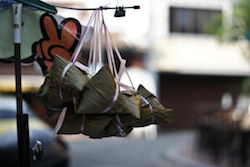 |
|
Poultry & eggs in Southeast Asia festivals
Sweet or Savory? One has an assortment of choices when it comes to purchasing ‘Bak Chang’ (rice dumplings).
The story of rice dumplings begins with the tale of Qu Yuan, a minister of state during the Warring States era of China who failed to prevent the invasion of his homeland. Out of grief, Qu Yuan killed himself by drowning in the Miluo River. Wanting to preserve his body, the public threw cooked rice wrapped in bamboo leaves into the river, believing that the fishes will eat the dumplings instead1. Fishermen also hit their oars against the water to scare the fishes away. This led to the annual dragon boat races and dumpling feasts.
Served during the Dragon Boat Festival2, dumplings are believed to be more than just a traditional Chinese food3.
Wrapped in bamboo leaves, the shape of rice dumplings varies. Some comes in a pyramid shape, while others are in cylinder form. Dumplings will consist of glutinous rice and varying fillings depending on the region. For example, some parts of Southern China may add an egg inside while Northern China fills it with red bean paste and taro to make sweet rice dumplings.
As traditions evolve over time, many have adapted and customized the flavors of their rice dumplings. Roasted duck and salted egg yolk4 are examples of “modern” poultry ingredients being used these days.
Similar to how rice dumplings are used to mark the celebration of Dragon Boat Festival, Indonesians prepare ‘Tumpeng’ (a local ceremonial dish) to celebrate joyous or significant events like Indonesia’s Independence Day5.
Originating from the Javanese culture6, Tumpeng acts as a symbol for gratitude and has been widely adapted in many Indonesian cities.
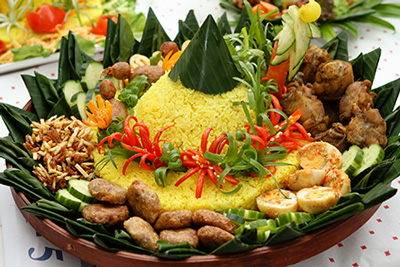
Credit: Flickr
Rice, the main ingredient, is shaped into a cone to symbolize a mountain. Surrounding it is a variety of cooked meat and vegetables that represents the life and harmony of nature. Side dishes vary depending on the occasion and region with items such as eggs being added to the mix.
For a traditional Tumpeng dish, eggs symbolize winged beasts like birds. However, in ‘Tumpeng Nujuh Bulan’ (a dish prepared for pregnant women during the 7 months), eggs are placed to signify the birth of life.
Poultry ingredients are used to signify land animals such as chicken and duck. A range of cooking styles is adopted when preparing these side dishes. From frying to grilling, the side dishes vary depending on the occasion. It could be ‘ayam goreng’ (fried chicken), shredded omelet or other favored Indonesian dishes.
Connecting the respective cooking traditions, Tumpeng was declared the country’s national dish in 20147. Ranging from being a vegetarian meal to including meats, poultry and seafood, Tumpeng was also listed as one of the 30 iconic Indonesian dishes by the Tourism and Creative Economy Ministry in 20138.
References:
1 Wikipedia. (2016). Zongzi. [online] Available at: https://en.wikipedia.org/wiki/Zongzi
2 Yoursingapore.com. (2016). Dragon Boat Festival. [online] Available at: http://www.yoursingapore.com/festivals-events-singapore/cultural-festivals/dragon-boat-festival.html
3 Bai, M. (2016). Zongzi, Traditional Snack for Dragon Boat Festival. Cits.net. [online] Available at: http://www.cits.net/china-guide/china-traditions/zongzi.html
4 Leong, C. (2016). 8 tastiest rice dumplings (bak chang) for 2015. herworldPLUS. [online] Available at: http://www.herworldplus.com/solutions/road-test/8-must-try-rice-dumplings-2015
5 f3nd1.com. (2012). Nasi Tumpeng – Its Meaning and Function - f3nd1.com. [online] Available at: http://www.f3nd1.com/2012/02/nasi-tumpeng-its-meaning-and-function/
6 BonAppetour. (2016). Nasi Tumpeng - A Celebratory feast! [online] Available at: https://www.bonappetour.com/nadyanajosky/nasi-tumpeng
7 Natahadibrata, N. (2014). Celebratory rice cone dish to represent the archipelago. The Jakarta Post. [online] Available at: http://www.thejakartapost.com/news/2014/02/10/celebratory-rice-cone-dish-represent-archipelago.html
8 Indonesia.gr. (2016). Indonesia’s thirty iconic dishes | Embassy of Indonesia, Athens. [online] Available at: http://indonesia.gr/indonesias-thirty-iconic-dishes
|
|
Credit: Flickr |
|
Disclaimer: All opinions and views expressed in the articles published in the newsletter are those of the individual journalists and do not necessarily reflect those of the publisher, the newsletter's sponsors or USA Poultry & Egg Export Council.
You have received this email because you have registered to get newsletters from USAPEEC ASEAN.
If you prefer not to receive these updates, please
click here
to unsubscribe.
Do not reply to this email. For enquiries, go to www.usapeecasean.com
® USA POULTRY & EGG EXPORT COUNCIL
541 Orchard Road, #15-04, Liat Towers, Singapore 238881 Tel: (65) 67371726 Fax: (65) 67371727
*|REWARDS|* |
|
|
|